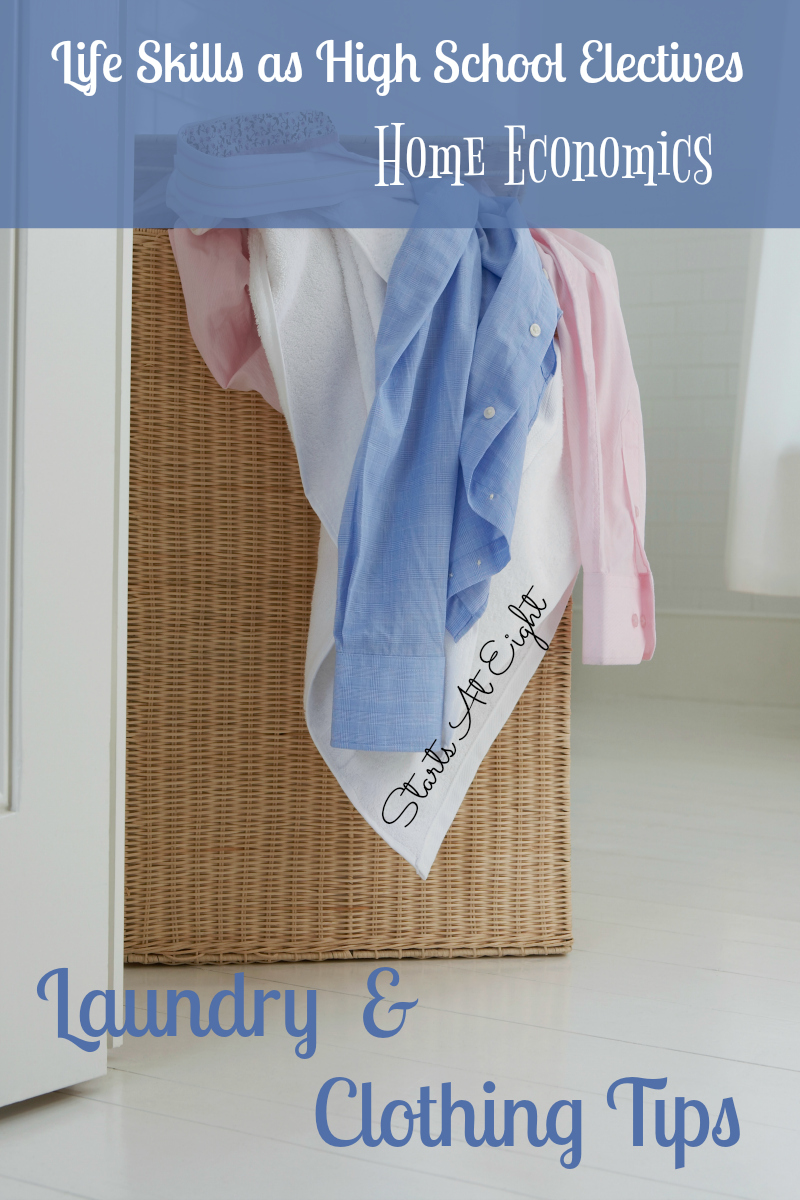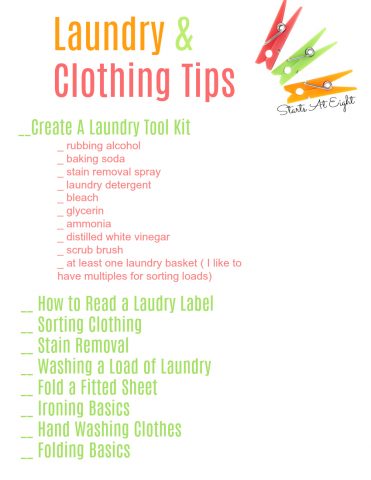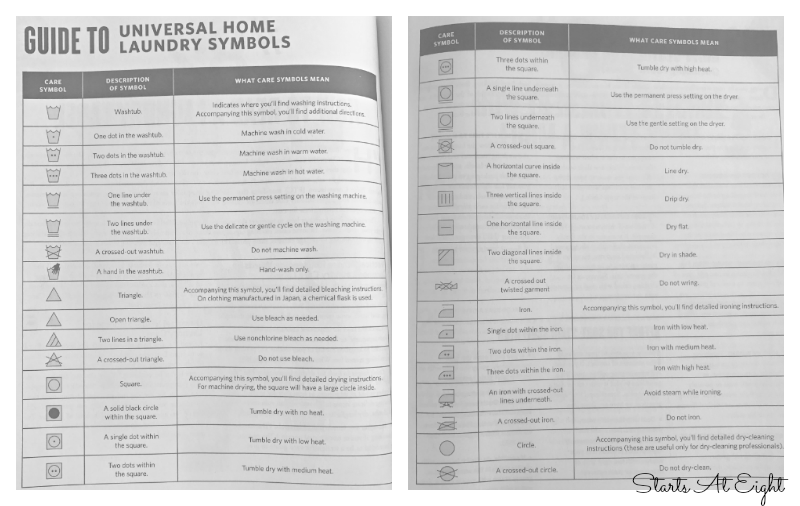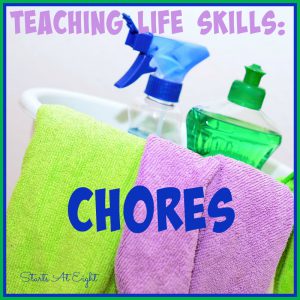Life Skills as High School Electives: Laundry and Clothing Tips
I recall a story I find myself telling when discussion of life skills – specifically home economics types of stuff – comes up. While it isn’t directly laundry and clothing tips related, it is very similar. It speaks to how easily we can take for granted some of the seemingly basic household tasks.
Many years ago I asked my very capable daughter to start the dishwasher for me as we were scurrying around to get out of the house that day. I was busy with her younger siblings and thus asked her to complete that for me before we headed out. Luckily she started it BEFORE we left because as I prepared to head out the door cascades of bubbles began to pour out of the dishwasher! I was stunned and scurried over to shut it down before any more came pouring out!
Turns out that what I assumed was simple, wasn’t as it seemed. I had failed to make it clear that the dish washing soap, and dish washer soap were two separate cleaners. She filled the reservoir up with dish washing soap, set the dishwasher to run, and off we were going to go!
This is one of the many reasons I place an emphasis on life skills, particularly as high school electives. It is our last chance to be sure we have taught them the necessary skills to navigate the world without us, and a great way for them to earn high school credit doing it!

Welcome to my series Life Skills as High School Electives: Home Economics and Shop Class. In this installment we are covering laundry and clothing tips. You may find they already know how to do some of these tasks, so feel free to check those right off! Others you may not have covered yet, or even thought of! Be sure to grab my Life Skills as High School Electives: Laundry and Clothing Tips printable list at the end of this post!
Laundry and Clothing Tips
Create a Laundry Tool Kit
- rubbing alcohol
- baking soda
- stain removal spray
- laundry detergent
- bleach
- glycerin
- ammonia
- distilled white vinegar
- scrub brush
- at least one laundry basket ( I like to have multiples for sorting loads)
How to Read a Laundry Label
Find the Label & Read the Directions
- Labels are often located in the collars of shirts, the waistbands of pants, and sometimes down the side seams of shirts and skirts.
- Check the label for important instructions like “wash separately” or dry-clean only.”
- Look for drying instructions such as “air-dry” or “tumble dry low.” How you dry is just as important as how you wash. Placing certain items can be damaged in the dryer such as things that are 100% which will shrink when dried.
- Interpret any laundry symbols on the label. Below is an image of some common and universal laundry symbols. Click on the image below to enlarge.
- Read what the garment is made of as that can give you clues as to how to handle it.
Sorting Clothing
- Start by gathering all the dirty clothes and linens together.
- Remove the obvious “not wash” or “special care” items such a delicate silks, wool sweaters, etc.
- Do a large sort of lights vs. darks.
- Often people will do a separate white only load in which they use bleach to help keep their whites white. But you do not have to do this. You can simply do one light colored (non-color bleeding items).
- Pull out lint-shedding items such as towels, bath robes, etc and wash them together so they don’t shed their lint on things that attract lint!
- When it comes to darks I often wash one load of noncolorfast items together including red garments, denim, new black, navy and deep purple items. The rest of the darks can be washed together.
- Wash heavily soiled items separately (with us that is often clothes worn at the horse barn, sports clothes such as wet and muddy socks, pants, etc.)
Stain Removal
- Remove as much of the substance off as you can without smearing it or pushing it in to the fabric.
- Force it back out by running cold water through the back of the stained fabric. This forces the stain back out. (Don’t run it through the front as that will only cause it to set deeper.
- Rub a liquid detergent into the stain using a gentle circular motion.
- Lather, rinse, and repeat until the stain is fully gone. Hold it up to the light. If you see even the slightest hint of the stain, repeat the previous steps.
- The minute you get a chance apply a stain remover (see below for a list of Common Household Stain Removers). Allow it to sit and work on the stain for at least 30 minutes.
- Then launder as usual. Before drying hold up to the light again. DO NOT DRY unless the stain is completely gone because the heat can set it permanently.
Common Household Stain Removers
- Ammonia – helps fade perspiration stains from light colored and white shirts
- Baking Soda – removes odors
- Bleach – ONLY FOR WHITES
- Cream of Tartar – rust stains and food stains – mix with lemon juice to make a paste
- Liquid Dishwasher Detergent – great for stains that you might normally bleach
- Dishwashing Liquid – makes a great spot-treater. Use it undiluted on touch stains like chocolate
- Glycerin – Great for sticky stains such as tree sap, gum, and tar; also works on stains from juice and condiments
- Hydrogen Peroxide – Effective on blood stains and stains on bathroom tile and grout. (1 cup hydrogen peroxide with 1 tablespoon ammonia for a great liquid stain-fighter)
- Laundry Detergent – this is the first line of defense and a great option for spot treatment when you can’t launder or stain remove right away
- Meat Tenderizer – Mix with cold water to treat protein based stains such as blood, milk, broth, or egg yolk
- Rubbing Alcohol – Great for grass stains, shoe polish stains, and plant-based food stains
- Salt – can be used to put on red wine or grape juice stains to prohibit setting until fabric can be cleaned
- Seltzer – Safe for any fabric that can be treated with water. Keeps stains from setting and brings the staining substance to the surface of fabrics
- Shampoo – use on dirt and mud stains, cosmetic stains, and ring-around-the-collar
- Shaving Cream – this is a great emergency spot cleaner. Apply immediately to the fabric and rub the area with a wet washcloth
- WD – 40 – use for spot treating oil-based stains such as lipstick, salad dressing, meaty sauce, and motor oil
- White Vinegarr – makes a great spot treater for suede items; with other fabrics it’s great for beer or berry stains
Washing a Load of Laundry
After sorting the laundry as is outlined above, pick a pile to prepare for laundering. Be sure to scan for spots that need to be treated, empty pockets of any contents, and any items that have heavy hardware such as metal buttons should be turn inside out.
Add detergent, softner and bleach based on the washing machine instructions. The softer the water, the less detergent will be required. Never pour laundry chemicals directly onto garments. Be sure to place the liquids carefully into their dispensers.
Select the appropriate water temperature. Colors in cold water and whites in warm water. When bleaching whites, like sheets, use hot water.
Do NOT over stuff the washer or the clothing will not get clean.
After the wash cycle is complete, preparing for drying. Shake out each item to they’ll dry more quickly and with fewer wrinkles.
Empty the lint trap.
Dry like clothes together – heavy towels with other heavy towels, jeans with jeans, etc. Delicate items separate as not to get damaged by heavier items.
Remove from dryer as soon as the dry cycle is complete. Not doing so will leave you with very wrinkled clothing. Same goes for folding and hanging, the sooner this task is done, the better.
Fold a Fitted Sheet
Ironing Basics
Hand Washing Clothes
- Handwashing is not only for very delicate clothes, but is great when you need one item in a pinch!
- To begin with be sure you are working within a clean sink, or bucket. You don’t want to be getting your garment dirty!
- Use lukewarm water as warm-hot water can make clothing colors bleed.
- Use a detergent meant for delicate fabrics.
- Handwashing is best for items like lingerie, silk shirts, and scarves. Heavier items are hard to clean and rinse this way and will take tons of water to do so.
- Handwashing removes the stress of agitation that a washer would put on garments, even in a delicate cycle. Using your hands to “agitate” the garment is the key to handwashing.
- Rinse and repeat. It will take it least twice – if not several times – to thoroughly rinse clothing. Adding 1/4 distilled white vinegar to a sinkful of water or an 1/8 to a bucket of rinse water will help to dissolve detergent residue. Rinse twice after using vinegar.
Folding Basics
The KonMari Folding Method is just one method of folding. It is very popular for organization and space saving reasons. The concept comes from the book, The Life-Changing Magic of Tidying Up.
For the ones who only wanted a tutorial on a specific item you can jump to one of the following… T-Shirts 1:54 Long Sleeves 3:05 Tank-tops 4:14 Dress Shirts/Blouses 5:14 Jumpers 6:32 Hoodie 7:34 Dresses 9:00 Skirts 9:56 Jeans 10:07 Underwear 11:20 Mid-long Underwear 12:25 “Funtime” Underwear (Thongs) 12:48 Boxers 13:32 Bras 13:58 Socks 14:18 Long Socks 14:39 Tights 15:24 Swimwear 15:57
Printable List of Laundry and Clothing Tips
I have created a printable list of these basic laundry and clothing tips. You can print it and use it as a guide to check off as you teach your teen these skills.
Another great way to enhance your record keeping is to take photos, print out any directions or tutorials you found useful and create a portfolio with the Printable Checklists and other items. I like using a 3 ring binder and creating tabs for each section of this Life Skills series. It will make a great reference for them later!
FREE Printable List
Click FREE Laundry and Clothing Tips Checklist Printable to download the entire list in pdf format!

Life Skills as High School Electives: Home Economics & Shop Class Series
Be sure to book mark this page as this is the landing page for all of them!
Welcome to my series Life Skills as High School Electives: Home Economics and Shop Class. Over the coming weeks I will be talking about essential life skills and how to incorporate them into your high school transcript as high school electives. {Each topic will be linked here as they are completed.}
1. Home Economics
- Essentials for Stocking a Kitchen & Pantry
- Cooking Basics for Teens
- Sewing Basics for Teens
- Laundry and Clothing Tips {This Post}
- house cleaning
2. Shop Class
- Essential Household Repair Tool Kit
- Basic Household Repairs for Teens
- Basic Wood Working Projects
- plumbing and electrical
- mechanical







June 23, 2017 @ 6:34 am
This is very helpful. You’re right, there is a lot of knowledge that I take for granted and this is a well organized way to pass it on. Thank you!
June 26, 2017 @ 11:26 am
This is so AWESOME! Love it, thank you so much. Wow! I forgot to teach my kids a lot and I am absolutely sharing the how to fold a fitted sheet because I can’t do that. lol
June 26, 2017 @ 9:15 pm
This is wonderful! I think I need to reread this for my kids AND me!
June 27, 2017 @ 8:09 am
There is a way to fold a fitted sheet by putting two corners in together that I usually use but I like this one even better!
June 27, 2017 @ 8:10 am
Thank you! This series is proving to be a ton of work for me, but I think these things are so important for us to remember to teach our children!
June 27, 2017 @ 2:14 pm
Awesome post! We are getting ready to start laundry skills with my oldest so this will be perfect!
June 27, 2017 @ 2:36 pm
Absolutely brilliant! My kids have been cleaning since they could hold a toilet brush. They’ve been folding and putting away laundry for years, but I still get nervous about them doing their own laundry. I’m loving your step by step list. Sharing this with the kids this afternoon. They will be thrilled with the independence I’m giving them. lol!
June 27, 2017 @ 3:18 pm
I love this idea for a Home Ec elective. My mom used to teach Home Ec in high school and these were the things she taught the kids.
June 27, 2017 @ 9:52 pm
Haha! Yeah, I’m sure they’ll just be loving the freedom of doing their own laundry from start to finish! 🙂
Teaching Household Management Life Skills to Your Gifted Teen
August 9, 2017 @ 12:31 pm
[…] Laundry and I think her points are spot on. Be sure also, to check out Heidi’s the Laundry and Clothing Tips to teach your kids the ins and outs of laundry […]
October 13, 2017 @ 3:11 am
Great post! I once asked my teenage boy to clean the bathroom so he went and squirted bleach all over the shower walls and left it to do its thing. I went in and found the walls with streak where the bleach had landed. It took about a year to get the walls back to normal.
October 13, 2017 @ 4:24 am
Great & thorough post!
October 16, 2017 @ 3:06 pm
No there is a tough lesson learned! LOL!